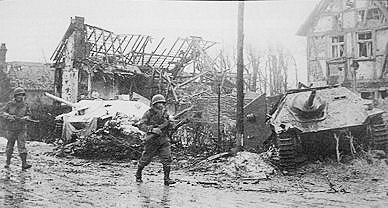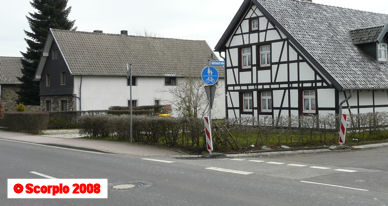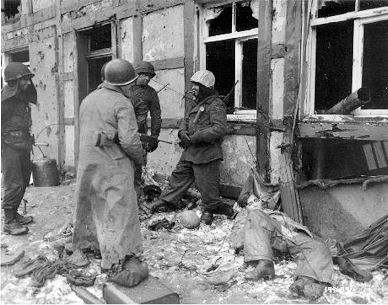in the Attack on Kesternich
30 January - 1 February 1945 - (Rhineland Campaign)
By Captain John H. Barner

THE LAST DAY OF THE ATTACK, 1 FEBRUARY
The final assault, preceded by a five minute artillery preparation, on enemy troops still defending KESTERNICH began at 1430 hours on 1 February. As a result of the previous day's operations the companies were disposed from north to south as follows: F Company; K Company, 310th Infantry; and G Company. E Company remained as the battalion reserve. 82
F Company pushed forward into the last remaining buildings included in Objective 27 and prior to darkness organized for the defense along the northeastern edge of the town.
K Company cleared the remaining buildings along the main street to the east of the triangle. Although K Company reported that all enemy personnel had been cleared from their zone it was learned at a later date that this report was not entirely correct.
G Company had the most difficult assignment for the day. Their objective included buildings 80 and 81 located just south of Objective 30. Any approach from the northwest or west of these buildings could be met with grazing fire and direct anti-tank fire by the enemy. The final plan for the reduction of these buildings included the following. The objective was to be placed under fire from the portion of K Company's area in the vicinity of buildings 82 and 79. The 2d Platoon of G Company plus the 2d Platoon of heavy machine guns from H Company was to support the attack with overhead fire from the forward slope of Objective 543. However as this platoon of machine guns displaced forward it was caught in a 50 mm mortar concentration which wounded four men including one section leader and one squad leader. The remaining two platoons of G Company were to make a frontal assault on the objective. The area over which this assault was to traverse sloped downward for approximately one-third of the distance. It then started upward with a gentle rise which included three hedgerows and over 50 yards of open field just before reaching the buildings.
At 1425 hours the artillery preparation began to fall. The Battalion Commander counted three direct hits on buildings 80 and 81 out of the first five rounds that landed. Suddenly twelve rounds landed in the vicinity of building 85 where the artillery forward observer was wounded. The Artillery Liaison Officer who was with the Battalion Commander Immediately gave the order to "cease fire".
The 1st and 3d Platoon of G Company moved forward in the assault. A technical sergeant, the acting 1st Platoon Leader, led his men across open ground for more than 300 yards to the snow filled draw and then up the slope through the three hedgerows which each contained a wire fence. The final enemy positions included entrenched enemy dug in behind a hedgerow with concertina wire 25 yards to the front. The sergeant arrived on his portion of the objective with his platoon guide, one BAR man, and two other riflemen. His aggressive advance permitted the 3d Platoon to move forward with a minimum of casualties although 50mm and 160mm mortar concentrations continued to fall in the area.
The 2d Platoon of G Company had not been able to contact the 3d Battalion on the south side of the draw but the fight for KESTERNICH was over. 83
This action and results thereof are summarized briefly as follows: Although the 2d Battalion, 311th Infantry failed to take its assigned objectives during the four hour period as directed by higher headquarters it did accomplish its mission in spite of unforeseen difficulties and unexpected enemy resistance.
A final count indicated that approximately 184 men and 6 officers had been killed, wounded, or evacuated for exposure. These casualties were, for the most part, from the actual assault elements of the battalion such as the rifle platoons and supporting heavy weapons crews.
Graves Registration personnel recovered approximately 400 German dead of which it was estimated that 260 were a result of this attack; the balance remained from the previous action in the town during the 16th and 17th of December, 1944.
During four successive months of combat the 78th Infantry Division personnel earned one Medal of Honor and nine Distinguished Service Crosses. Of this total Sergeant Jonah Kelley, E Company, received the Medal of Honor while two of the Distinguished Services Grosses were awarded to members of the 2d Battalion for actions performed in KESTERNICH. For this action the 2d Battalion was awarded the Presidential Distinguished Unit Badge by General Order Number 11, War Department, dated 30 January 1946.
Cedrlc Foster, noted wartime radio news commentator, covered many of the events narrated in this monograph over his national network hook-up. In summing up the operation he dubbed KESTERNICH with the name "Little Aachen" by comparing the German resistance offered in this area to that of the well known defense of AACHEN. 84
 |
 |
| 31 Jan 1945 : US 78th Infantry Division soldiers advancing through
Kesternich, passing two knocked-out Hetzers among residential ruins.
|
The main street (Hauptstrasse 80) of Kesternich in 2008.
|
 |
 |
| GIs from the 311th Infantry Regiment inside the Village of Kesternich, February 1944.
|
The same spot today (Hauptstrasse 56) of Kesternich in 2008.
|

